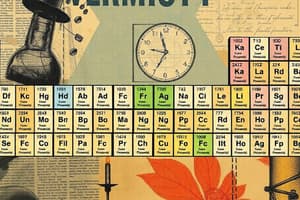Podcast
Questions and Answers
What was the main conclusion of J.J. Thomson's cathode ray experiment?
What was the main conclusion of J.J. Thomson's cathode ray experiment?
- Atoms consist of a large positively charged nucleus
- Atoms contain only protons and neutrons
- Atoms contain small negatively charged electrons (correct)
- Atoms are indivisible and cannot be subdivided
What did Rutherford's gold foil experiment demonstrate about the atom?
What did Rutherford's gold foil experiment demonstrate about the atom?
- The atom is composed of equal numbers of protons and electrons
- The atom consists of a uniform distribution of positive and negative charges
- The atom is a solid, indivisible particle
- The atom contains mostly empty space and a large positively charged nucleus (correct)
What did Johann Dobereiner's triads aim to demonstrate?
What did Johann Dobereiner's triads aim to demonstrate?
- The existence of isotopes
- The periodic law of elements
- The atomic structure of elements
- Elements with similar properties could be grouped together (correct)
What was the contribution of John Newlands to the organization of the periodic table?
What was the contribution of John Newlands to the organization of the periodic table?
How many types of orbitals (s, p, d, f) are there?
How many types of orbitals (s, p, d, f) are there?
Where are valence electrons located in an atom?
Where are valence electrons located in an atom?
How many electrons can the first energy level hold in the s orbital?
How many electrons can the first energy level hold in the s orbital?
How are valence electrons for elements (excluding transition metals) determined?
How are valence electrons for elements (excluding transition metals) determined?
What did the Gold Foil Experiment, conducted by Rutherford, Geiger, and Marsden, aim to understand?
What did the Gold Foil Experiment, conducted by Rutherford, Geiger, and Marsden, aim to understand?
What did J.J. Thomson's experiments with cathode rays challenge?
What did J.J. Thomson's experiments with cathode rays challenge?
What did Democritus propose with the concept of 'atomos'?
What did Democritus propose with the concept of 'atomos'?
What determines an element's reactivity and properties?
What determines an element's reactivity and properties?
What did Henry Moseley's work with Ernest Rutherford lead to?
What did Henry Moseley's work with Ernest Rutherford lead to?
What are the key properties of elements on the periodic table?
What are the key properties of elements on the periodic table?
Where are the elements with large ionization energy, electronegativity, and electron affinity located on the periodic table?
Where are the elements with large ionization energy, electronegativity, and electron affinity located on the periodic table?
How does metallic character vary on the periodic table?
How does metallic character vary on the periodic table?
What is an element?
What is an element?
Why is water not considered an element?
Why is water not considered an element?
What are atoms made of?
What are atoms made of?
Are elements and chemicals the same?
Are elements and chemicals the same?
Flashcards are hidden until you start studying
Study Notes
The Periodic Table: Evolution and Organization
- Dmitri Mendeleev is known as the "Father of the Periodic Table" for his contributions, placing the known chemical elements in order of increasing atomic weight, discovering patterns in the table.
- Henry Moseley, working with Ernest Rutherford, determined that elements should be arranged by increasing atomic number, leading to the modern periodic table organization.
- Mendeleev proposed the periodic table in 1869, with 56 known elements, while Moseley's 1913 version included 74 known elements.
- The periodic table is organized into periods (horizontal rows) and groups (vertical columns), aiding in the identification of element properties.
- There are seven periods and eight groups on the periodic table, despite appearing to have nine rows due to the placement of the two bottom rows.
- Groups, also called periodic families, have special names and contain elements with similar chemical properties.
- The periodic table includes metals, metalloids, and nonmetals, with a "staircase" indicating the metalloids.
- Valence electrons, atomic radii, ionization energy, electronegativity, electron affinity, and metallic character are key properties of elements on the periodic table.
- Valence electrons increase across a period, while atomic radii increase down a group but decrease across a period.
- Elements in the upper right corner of the periodic table have large ionization energy, electronegativity, and electron affinity.
- Atoms with high oxidizing nature, found in the upper right corner, have a large ionization energy, smaller atomic radius, and a larger number of valence electrons.
- Metallic character is large for elements in the bottom left corner, increasing down a group but decreasing across a period.
Studying That Suits You
Use AI to generate personalized quizzes and flashcards to suit your learning preferences.




